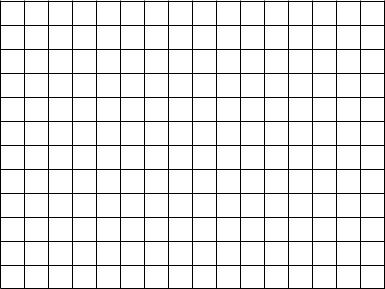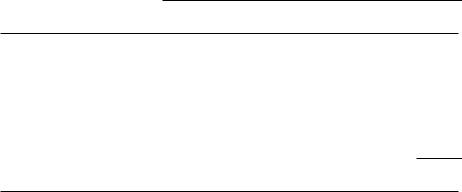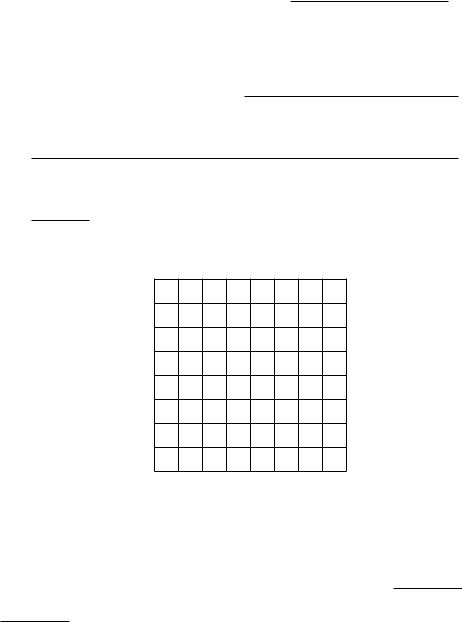
Varian Microeconomics Workout
.pdf
The problems in this chapter examine some variations on the apartment market described in the text. In most of the problems we work with the true demand curve constructed from the reservation prices of the consumers rather than the \smoothed" demand curve that we used in the text.
Remember that the reservation price of a consumer is that price where he is just indi®erent between renting or not renting the apartment. At any price below the reservation price the consumer will demand one apartment, at any price above the reservation price the consumer will demand zero apartments, and exactly at the reservation price the consumer will be indi®erent between having zero or one apartment.
You should also observe that when demand curves have the \staircase" shape used here, there will typically be a range of prices where supply equals demand. Thus we will ask for the the highest and lowest price in the range.
1.1 (3) Suppose that we have 8 people who want to rent an apartment. Their reservation prices are given below. (To keep the numbers small, think of these numbers as being daily rent payments.)
Person |
= |
A |
B |
C |
D |
E |
F |
G |
H |
Price |
= |
40 |
25 |
30 |
35 |
10 |
18 |
15 |
5 |
(a) Plot the market demand curve in the following graph. (Hint: When the market price is equal to some consumer i's reservation price, there will be two di®erent quantities of apartments demanded, since consumer i will be indi®erent between having or not having an apartment.)

Price
60
50
40
30
20
10
0 |
1 |
2 |
3 |
4 |
5 |
6 |
7 |
8 |
|
|
|
|
|
|
|
Apartments |
|
(b) Suppose the supply of apartments is ¯xed at 5 units. In this case there is a whole range of prices that will be equilibrium prices. What is the highest price that would make the demand for apartments equal to 5
units? |
|
. |
(c) What is the lowest price that would make the market demand equal
to 5 units? |
|
. |
(d) With a supply of 4 apartments, which of the people A{H end up
getting apartments? |
|
. |
(e) What if the supply of apartments increases to 6 units. What is the
range of equilibrium prices? |
|
. |
1.2 (3) Suppose that there are originally 5 units in the market and that 1 of them is turned into a condominium.

(a) Suppose that person A decides to buy the condominium. What will be the highest price at which the demand for apartments will equal the supply of apartments? What will be the lowest price? Enter your answers in column A, in the table. Then calculate the equilibrium prices of apartments if B, C, : : : , decide to buy the condominium.
Person |
A |
B |
C |
D |
E |
F |
G |
H |
High price |
|
|
|
|
|
|
|
|
|
|
|
|
|
|
|
|
|
Low price |
|
|
|
|
|
|
|
|
|
|
|
|
|
|
|
|
|
(b) Suppose that there were two people at each reservation price and 10 apartments. What is the highest price at which demand equals supply?
Suppose that one of the apartments was turned into a condo-
minium. Is that price still an equilibrium price? |
|
. |
1.3 (2) Suppose now that a monopolist owns all the apartments and that he is trying to determine which price and quantity maximize his revenues.
(a) Fill in the box with the maximum price and revenue that the monopolist can make if he rents 1, 2, : : :, 8 apartments. (Assume that he must charge one price for all apartments.)
Number |
1 |
2 |
3 |
4 |
5 |
|
|
6 |
7 |
|
8 |
|
Price |
|
|
|
|
|
|
|
|
|
|
|
|
|
|
|
|
|
|
|
|
|
|
|
|
|
Revenue |
|
|
|
|
|
|
|
|
|
|
|
|
|
|
|
|
|
|
|
|
|
|
|
|
|
(b) Which of the people A{F would get apartments? |
|
|
|
|
. |
|
||||||
(c) If the monopolist were required by law to rent exactly 5 apartments, |
|
|||||||||||
what price would he charge to maximize his revenue? |
|
|
|
. |
|
|||||||
(d) Who would get apartments? |
|
|
|
|
|
|
|
. |
|
|||
(e) If this landlord could charge each individual a di®erent price, and he knew the reservation prices of all the individuals, what is the maximum
revenue he could make if he rented all 5 apartments? |
|
. |
|

(f) If 5 apartments were rented, which individuals would get the apart-
ments? |
|
. |
1.4 (2) Suppose that there are 5 apartments to be rented and that the city rent-control board sets a maximum rent of $9. Further suppose that people A, B, C, D, and E manage to get an apartment, while F, G, and H are frozen out.
(a) If subletting is legal|or, at least, practiced|who will sublet to whom in equilibrium? (Assume that people who sublet can evade the city
rent-control restrictions.)
.
(b) What will be the maximum amount that can be charged for the sublet
payment? |
|
. |
(c) If you have rent control with unlimited subletting allowed, which of
the consumers described above will end up in the 5 apartments?
.
(d) How does this compare to the market outcome? |
|
. |
1.5 (2) In the text we argued that a tax on landlords would not get passed along to the renters. What would happen if instead the tax was imposed on renters?
(a) To answer this question, consider the group of people in Problem 1.1. What is the maximum that they would be willing to pay to the landlord if they each had to pay a $5 tax on apartments to the city? Fill in the box below with these reservation prices.
Person |
A |
B |
C |
D |
E |
F |
|
|
G |
H |
|||
Reservation Price |
|
|
|
|
|
|
|
|
|
|
|
|
|
|
|
|
|
|
|
|
|
|
|
|
|
|
|
(b) Using this information determine the maximum equilibrium price if |
|
|
|||||||||||
there are 5 apartments to be rented. |
|
|
|
|
|
. |
|
|
|||||
|
|
|
|
|
|
|
|||||||
(c) Of course, the total price a renter pays consists of his or her rent plus |
|
|
|||||||||||
the tax. This amount is |
|
|
|
|
|
|
|
. |
|
|
|||
|
|
|
|
|
|
|
|
|
|||||
(d) How does this compare to what happens if the tax is levied on the |
|
|
|||||||||||
landlords? |
|
|
|
|
|
|
|
|
|
. |
|
|
|

These workouts are designed to build your skills in describing economic situations with graphs and algebra. Budget sets are a good place to start, because both the algebra and the graphing are very easy. Where there are just two goods, a consumer who consumes x1 units of good 1 and x2 units of good 2 is said to consume the consumption bundle, (x1; x2). Any consumption bundle can be represented by a point on a two-dimensional graph with quantities of good 1 on the horizontal axis and quantities of good 2 on the vertical axis. If the prices are p1 for good 1 and p2 for good 2, and if the consumer has income m, then she can a®ord any consumption bundle, (x1; x2), such that p1x1 + p2x2 · m. On a graph, the budget line is just the line segment with equation p1x1 + p2x2 = m and with x1 and x2 both nonnegative. The budget line is the boundary of the budget set. All of the points that the consumer can a®ord lie on one side of the line and all of the points that the consumer cannot a®ord lie on the other.
If you know prices and income, you can construct a consumer's budget line by ¯nding two commodity bundles that she can \just a®ord" and drawing the straight line that runs through both points.
Myrtle has 50 dollars to spend. She consumes only apples and bananas. Apples cost 2 dollars each and bananas cost 1 dollar each. You are to graph her budget line, where apples are measured on the horizontal axis and bananas on the vertical axis. Notice that if she spends all of her income on apples, she can a®ord 25 apples and no bananas. Therefore her budget line goes through the point (25; 0) on the horizontal axis. If she spends all of her income on bananas, she can a®ord 50 bananas and no apples. Therfore her budget line also passes throught the point (0; 50) on the vertical axis. Mark these two points on your graph. Then draw a straight line between them. This is Myrtle's budget line.
What if you are not told prices or income, but you know two commodity bundles that the consumer can just a®ord? Then, if there are just two commodities, you know that a unique line can be drawn through two points, so you have enough information to draw the budget line.
Laurel consumes only ale and bread. If she spends all of her income, she can just a®ord 20 bottles of ale and 5 loaves of bread. Another commodity bundle that she can a®ord if she spends her entire income is 10 bottles of ale and 10 loaves of bread. If the price of ale is 1 dollar per bottle, how much money does she have to spend? You could solve this problem graphically. Measure ale on the horizontal axis and bread on the vertical axis. Plot the two points, (20; 5) and (10; 10), that you know to be on the budget line. Draw the straight line between these points and extend the line to the horizontal axis. This point denotes the amount of ale Laurel can a®ord if she spends all of her money on ale. Since ale costs 1 dollar a bottle, her income in dollars is equal to the largest number of bottles she
can a®ord. Alternatively, you can reason as follows. Since the bundles (20; 5) and (10; 10) cost the same, it must be that giving up 10 bottles of ale makes her able to a®ord an extra 5 loaves of bread. So bread costs twice as much as ale. The price of ale is 1 dollar, so the price of bread is 2 dollars. The bundle (20; 5) costs as much as her income. Therefore her income must be 20 £ 1 + 5 £ 2 = 30.
When you have completed this workout, we hope that you will be able to do the following:
²Write an equation for the budget line and draw the budget set on a graph when you are given prices and income or when you are given two points on the budget line.
²Graph the e®ects of changes in prices and income on budget sets.
²Understand the concept of numeraire and know what happens to the budget set when income and all prices are multiplied by the same positive amount.
²Know what the budget set looks like if one or more of the prices is negative.
²See that the idea of a \budget set" can be applied to constrained choices where there are other constraints on what you can have, in addition to a constraint on money expenditure.

2.1 (0) You have an income of $40 to spend on two commodities. Commodity 1 costs $10 per unit, and commodity 2 costs $5 per unit.
(a) Write down your budget equation. .
(b) If you spent all your income on commodity 1, how much could you
buy? .
(c) If you spent all of your income on commodity 2, how much could you
buy? Use blue ink to draw your budget line in the graph below.
x2
8
6
4
2
0 |
2 |
4 |
6 |
8 |
|
|
|
|
x1 |
(d) Suppose that the price of commodity 1 falls to $5 while everything
else stays the same. Write down your new budget equation.
On the graph above, use red ink to draw your new budget
line.
(e) Suppose that the amount you are allowed to spend falls to $30, while the prices of both commodities remain at $5. Write down your budget
equation. |
|
Use black ink to draw this budget line. |
(f) On your diagram, use blue ink to shade in the area representing commodity bundles that you can a®ord with the budget in Part (e) but could not a®ord to buy with the budget in Part (a). Use black ink or pencil to shade in the area representing commodity bundles that you could a®ord with the budget in Part (a) but cannot a®ord with the budget in Part
(e).
2.2 (0) On the graph below, draw a budget line for each case.

(a)p1 = 1, p2 = 1, m = 15. (Use blue ink.)
(b)p1 = 1, p2 = 2, m = 20. (Use red ink.)
(c)p1 = 0, p2 = 1, m = 10. (Use black ink.)
(d)p1 = p2, m = 15p1. (Use pencil or black ink. Hint: How much of good 1 could you a®ord if you spend your entire budget on good 1?)
x2
20
15
10
5
0 |
5 |
10 |
15 |
20 |
|
|
|
|
x1 |
2.3 (0) Your budget is such that if you spend your entire income, you can a®ord either 4 units of good x and 6 units of good y or 12 units of x and 2 units of y.
(a) Mark these two consumption bundles and draw the budget line in the graph below.
y
16
12
8
4
0 |
4 |
8 |
12 |
16 |
|
|
|
|
x |

(b) What is the ratio of the price of x to the price of y? |
|
. |
|
(c) If you spent all of your income on x, how much x could you buy?
.
(d) If you spent all of your income on y, how much y could you buy?
.
(e) Write a budget equation that gives you this budget line, where the
price of x is 1. |
|
. |
(f) Write another budget equation that gives you the same budget line,
but where the price of x is 3. |
|
. |
2.4 (1) Murphy was consuming 100 units of X and 50 units of Y . The price of X rose from 2 to 3. The price of Y remained at 4.
(a) How much would Murphy's income have to rise so that he can still
exactly a®ord 100 units of X and 50 units of Y ? |
|
. |
2.5 (1) If Amy spent her entire allowance, she could a®ord 8 candy bars and 8 comic books a week. She could also just a®ord 10 candy bars and 4 comic books a week. The price of a candy bar is 50 cents. Draw her
budget line in the box below. What is Amy's weekly allowance? |
|
. |
Comic books
32
24
16
8
0 |
8 |
16 |
24 |
32 |
|
|
|
Candy bars |
|

2.6 (0) In a small country near the Baltic Sea, there are only three commodities: potatoes, meatballs, and jam. Prices have been remarkably stable for the last 50 years or so. Potatoes cost 2 crowns per sack, meatballs cost 4 crowns per crock, and jam costs 6 crowns per jar.
(a) Write down a budget equation for a citizen named Gunnar who has an income of 360 crowns per year. Let P stand for the number of sacks of potatoes, M for the number of crocks of meatballs, and J for the number
of jars of jam consumed by Gunnar in a year. |
|
. |
(b) The citizens of this country are in general very clever people, but they are not good at multiplying by 2. This made shopping for potatoes excruciatingly di±cult for many citizens. Therefore it was decided to introduce a new unit of currency, such that potatoes would be the numeraire. A sack of potatoes costs one unit of the new currency while the same relative prices apply as in the past. In terms of the new currency, what is
the price of meatballs? |
|
|
. |
(c) In terms of the new currency, what is the price of jam? |
|
. |
|
(d) What would Gunnar's income in the new currency have to be for him to be exactly able to a®ord the same commodity bundles that he could
a®ord before the change? |
|
|
|
|
. |
|
|
|
|
||
(e) Write down Gunnar's new budget equation. |
|
|
Is |
||
Gunnar's budget set any di®erent than it was before the change? |
|
|
|
||
2.7 (0) Edmund Stench consumes two commodities, namely garbage and punk rock video cassettes. He doesn't actually eat the former but keeps it in his backyard where it is eaten by billy goats and assorted vermin. The reason that he accepts the garbage is that people pay him $2 per sack for taking it. Edmund can accept as much garbage as he wishes at that price. He has no other source of income. Video cassettes cost him $6 each.
(a) If Edmund accepts zero sacks of garbage, how many video cassettes
can he buy? .
(b) If he accepts 15 sacks of garbage, how many video cassettes can he
buy? .
